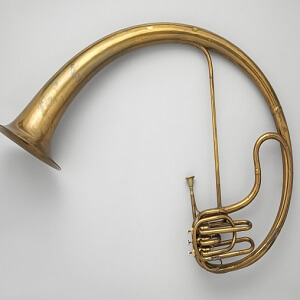Saxtuba
 The saxtuba is an obsolete valved brasswind instrument conceived by the Belgian instrument-maker Adolphe Sax around 1845. The design of the instrument was inspired by the ancient Roman cornu and tuba. The saxtubas, which comprised a family of half-tube and whole-tube instruments of varying pitches, were first employed in Fromental Halévy's opera Le Juif errant (The Wandering Jew) in 1852. Their only other public appearance of note was at a military ceremony on the Champ de Mars in Paris in the same year. The term "saxtuba" may also refer to the bass saxhorn.
The saxtuba is an obsolete valved brasswind instrument conceived by the Belgian instrument-maker Adolphe Sax around 1845. The design of the instrument was inspired by the ancient Roman cornu and tuba. The saxtubas, which comprised a family of half-tube and whole-tube instruments of varying pitches, were first employed in Fromental Halévy's opera Le Juif errant (The Wandering Jew) in 1852. Their only other public appearance of note was at a military ceremony on the Champ de Mars in Paris in the same year. The term "saxtuba" may also refer to the bass saxhorn.
In the 1770s, the French artist Jacques-Louis David carried out extensive researches into the ancient Roman instruments that appeared on Trajan's Column in Rome. Two of these instruments – the straight tuba and the curved cornu – were revived in Revolutionary France as the buccin and tuba curva. To devise the saxtubas Sax merely added valves to these natural instruments, thus providing them with chromatic compasses. Furthermore, he designed them in such a way that the valves were hidden from general view, thus giving the impression that the instruments were primitive natural trumpets only capable of playing notes from a single harmonic series.
The saxtuba was first conceived by Sax at his workshop in the Rue Saint-Georges in Paris around 1845. On 5 May 1849 Sax applied for a patent for a series of brasswind instruments fitted with cylinders. On 16 July 1849 he was granted French Patent 8351. The saxtubas were patented in 1852, in a certificate of addition to the main patent of 1849. Like Sax's saxhorns and saxotrombas, which were also covered by this patent, the saxtubas were equipped with pavillons tournants – that is to say, their bells could be pointed forward – which was considered ideal for instruments intended to be played by marching or mounted bands in the open air.